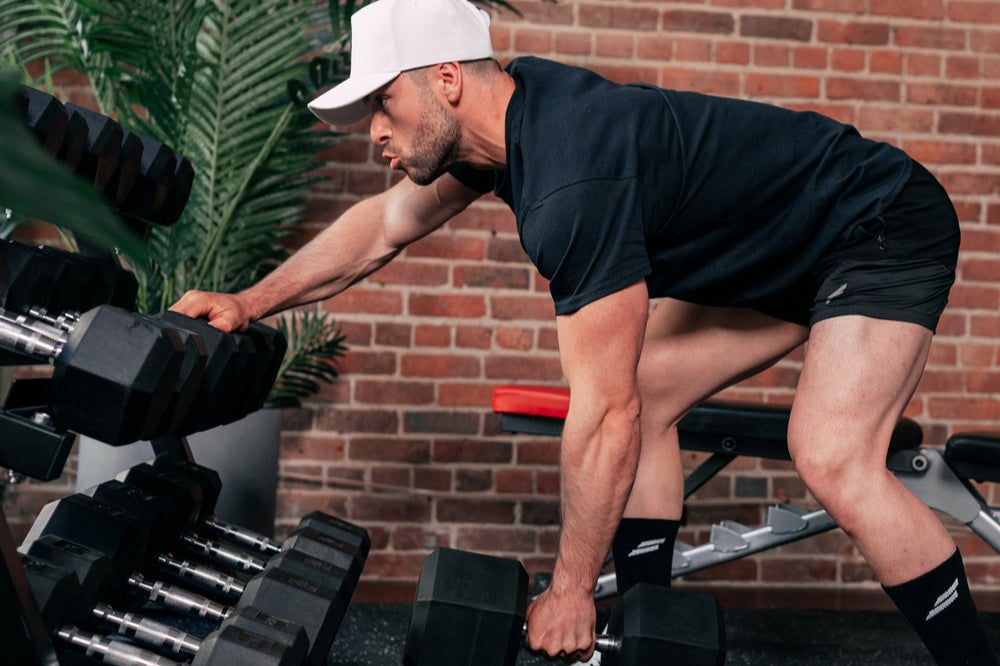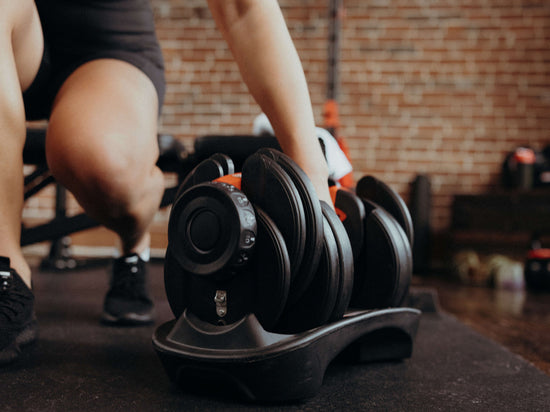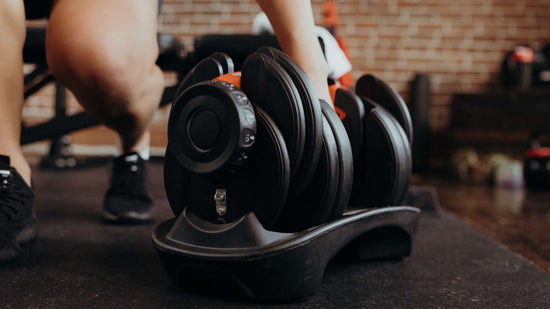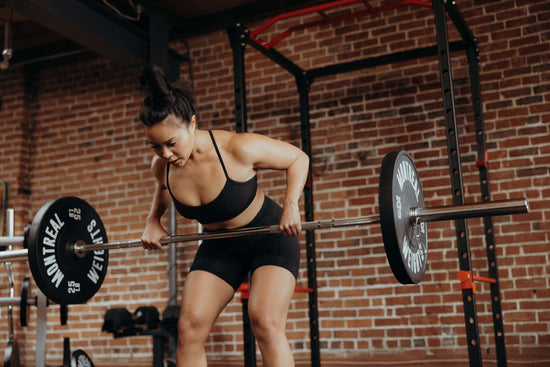A strong back is crucial for good posture, proper movement, and overall fitness. It supports the spine, allowing us to lift, twist, and bend without pain or injury. And you don’t need fancy gym machines or large barbells and plates to get a swole back, either. Dumbbells are versatile free weights that can be used to effectively target specific muscles in the back and upper body.
Read on for our top 7 back exercises you can do with dumbbells including variations and modifications.
Benefits of Having a Strong Back
Having a strong back has several benefits, including:
Improved posture: A strong back helps to align the spine and improve posture, reducing the risk of back pain and injury.
Increased flexibility: Strong back muscles allow for greater range of motion and flexibility, making daily activities easier to perform.
Better athletic performance: A strong back is essential for many sports and activities, such as swimming, rowing, and weightlifting.
Reduced risk of injury: A strong back helps to stabilize the spine and reduce the risk of injury during physical activity.
How Do You Work Out Your Back With Dumbbells?
To work out your back with dumbbells back you can perform exercises such as dumbbell rows, reverse fly, shrugs, deadlifts, and pull-overs. These dumbbell back exercises target different areas of the back, including the lats, rhomboids, trapezius, and erector spinae.
When performing dumbbell back exercises, it's important to maintain proper form and control the weights throughout the entire movement because you won’t have the luxury of the same stability a barbell would give you. Start with lighter weights and gradually increase the weight as you become more comfortable with the exercises.
Do Dumbbells Help With the Back?
Yes, dumbbells can be an effective tool for strengthening and toning the back muscles. Dumbbells offer a wider range of motion compared to other equipment such as barbells or machines, allowing you to target specific areas of the back more effectively.
Using dumbbells also allows for greater flexibility and versatility in your workout routine, as you can easily adjust the weight and modify the exercises to target different areas of the back.
Using a Dumbbell vs. a Barbell for a Back Workout
When it comes to strengthening the back muscles, both dumbbells and barbells can be effective tools. However, there are key differences between the two that can impact your workout routine and yield varying benefits for your upper body.
One major difference is the range of motion and flexibility that dumbbells offer. Dumbbells allow for a greater range of motion, as each arm can move independently, allowing for more natural movement patterns and engaging stabilizer muscles. This can result in improved muscle imbalances and increased muscle activation in the back muscles.
Moreover, dumbbells offer versatility in terms of exercise variations and modifications. They can be used for a wide range of exercises, including rows, pullovers, and flyes, targeting different areas of the back and allowing for more targeted muscle isolation.
On the other hand, barbells are typically used for compound exercises such as deadlifts and barbell rows, which engage multiple muscle groups at once, including the back muscles. Barbells are typically heavier, requiring more stability and strength to handle, and can be beneficial for building overall strength and power.
In terms of benefits, using dumbbells for a back workout can offer advantages such as increased range of motion, improved muscle imbalances, and greater exercise variation. Barbells, on the other hand, can be beneficial for compound exercises and building overall strength.
It's important to note that the choice between dumbbells and barbells may depend on personal preference, fitness level, and specific fitness goals. Incorporating both dumbbells and barbells into your back workout routine can provide a well-rounded approach for targeting different muscle groups and maximizing your results.
How Do You Work Out Your Back With Dumbbells?
To work out with dumbbell back exercises, you can perform exercises such as dumbbell rows, reverse fly, shrugs, deadlifts, and pull-overs. These dumbbell back exercises target different areas of the back, including the lats, rhomboids, trapezius, and erector spinae.
When performing dumbbell back exercises, it's important to maintain proper form and control the weights throughout the entire movement. Start with lighter weights and gradually increase the weight as you become more comfortable with the exercises.
Benefits of Doing a Back Workout Using Dumbbells
Using dumbbells for a back workout has several benefits, including:
Strength equality: Using dumbbells means you’re using equal strength on both your left and right side, as the weights are free from each other.
Greater range of motion: Dumbbells allow for a greater range of motion, which can help to target specific muscles more effectively.
Improved stability: Using dumbbells requires greater stabilization, which can improve overall strength and stability.
Easily Accessible: You can use dumbbells anywhere! They do not take up as much space as a barbell and can easily be added to many existing workouts.
Versatility: Dumbbells can be used for a wide variety of exercises, allowing you to target different areas of the back and engage different muscle groups.
What Are Some Good Back Exercises With Weights? 7 Best Dumbbell Back Exercises
Dumbbell Bent Over Row
The bent over dumbbell row targets the upper back muscles, including the latissimus dorsi and rhomboids.
Steps to perform:
Stand with your feet hip width apart, knees slightly bent, and a dumbbell in each hand with a neutral grip (palms facing inward)
Hinge forward at the hips, keeping your back straight and chest up.
Bend your elbows and pull the dumbbells towards your hip, squeezing your shoulder blades together.
Lower the dumbbells back down with control to the starting position.
Variations/modifications:
Single-arm dumbbell bent over row: Perform the exercise with one arm at a time, elbows slightly bent and alternating sides.
Wide-grip bent over dumbbell row: Hold the dumbbells with an overhand grip (palms facing back) and pull with your elbow facing out toward the side to target the outer back muscles.
Underhand-grip bent over row: Hold the dumbbells with an underhand grip (palms facing the ceiling) to target the biceps as well as the back muscles.
Single Arm Dumbbell Row
The single arm dumbbell row targets the upper back muscles, including the latissimus dorsi and rhomboids.
Steps to perform:
Start by bending over a bench with one knee bent and the arm on the same side straight underneath you, providing support. Keep your other leg straight with your foot on the floor. Hold a dumbbell in your free hand, letting it hang straight down.
Keep your core tight and your back straight throughout the exercise. This will help you engage your back muscles effectively and minimize the risk of injury.
Engage your back muscles and pull the dumbbell up towards your belly button, slightly moving it backwards. Pause and squeeze your back muscles at the top position to maximize the contraction.
Lower the dumbbell back down to the starting position in a controlled manner. Avoid letting it swing or drop abruptly to maintain proper form and control.
Variations/modifications:
Wide-grip single arm dumbbell row: Hold the dumbbell with an overhand grip (palm facing back) and row with your elbow facing out toward the side to target the outer back muscles.
Dumbbell renegade row: Perform the exercise from a plank position, alternating between left and right arms.
Chest-support dumbbell row: Use a bench at a 45 degree incline to support your chest to isolate the buck muscles as you row.
Reverse Fly
The reverse fly targets the middle and upper back, including the rhomboids and trapezius.
Steps to perform:
Stand with feet shoulder width apart, knees slightly bent, and a dumbbell in each hand with a neutral grip.
Hinge forward at the hips, keeping your back straight and chest up.
Lift the dumbbells out to the sides, squeezing your shoulder blades together.
Lower the dumbbells back down to the starting position.
Variations/modifications:
Incline reverse fly: Perform the exercise on an incline bench with your chest supported to isolate the upper back muscles more effectively.
Seated reverse fly: Perform the exercise while seated and bent all the way over to target the middle and upper back.
Shrugs
Shrugs target the trapezius muscles in the upper back.
Steps to perform:
Stand with feet shoulder width apart, knees slightly bent, and a dumbbell in each hand with a neutral grip.
Lift your shoulders up towards your ears, squeezing your shoulder blades together.
Lower your shoulders back down to the starting position.
Variations/modifications:
Single-arm shrug: Perform the exercise with one arm at a time, alternating sides.
Behind-the-back shrug: Perform the exercise holding the dumbbells behind your back with palms facing back, targeting the lower trapezius muscles.
Deadlift
The deadlift targets the lower back, as well as the glutes and hamstrings.
Steps to perform:
Stand with feet hip-width apart, knees slightly bent, and a dumbbell in each hand.
Hinge forward at the hips, keeping your back straight and chest up.
Lower the dumbbells towards the ground, keeping them close to your shins (think “scraping your shins”.).
Engage your glutes to return back to your starting position.
Variations/modifications:
Single-leg deadlift: Perform the exercise on one leg at a time, alternating sides.
Romanian deadlift: Keep your knees slightly bent and lower the dumbbells towards your shins, targeting the hamstrings more effectively.
Sumo deadlift: Stand with feet wider than shoulder-width apart and toes pointed outwards, targeting the inner thighs and glutes.
Pull-Over
The pull-over targets the upper back, including the latissimus dorsi and trapezius.
Steps to perform:
Lie on a bench with your head and shoulders supported and one dumbbell held in both hands with palms facing each other.
Extend your arm straight up towards the ceiling, keeping your elbows slightly bent.
Take the dumbbell towards the back and over head, keeping your elbows close to your ears.
Lift the dumbbell back up to the starting position.
Variations/modifications:
Alternating pull-over: Hold a dumbbell in each hand and perform the exercise with one arm at a time, alternating sides.
Bridge pull-over: Perform the exercise while lying on your back with your knees bent and feet flat on the ground, targeting the glutes and hamstrings as well.
Incline pull-over: Perform the exercise on an incline bench to target the upper chest and shoulders as well as the back muscles.
Dumbbell Snatch
The dumbbell snatch primarily targets the muscles of the back, including the latissimus dorsi (lats), rhomboids, trapezius, and erector spinae.
Steps To Perform:
Stand with your feet shoulder width apart, holding a dumbbell in one hand with your arm straight down and palm facing towards you. Keep your back straight, core engaged, and knees slightly bent.
In one smooth motion, quickly extend your hips, knees, and ankles, and simultaneously pull the dumbbell up towards the ceiling, keeping your arm straight. As the dumbbell rises, rotate your arm so that your palm faces forward, and quickly transition to a partial squat, dropping under the dumbbell.
Catch the dumbbell overhead with your arm fully extended, standing up with your arm straight and core engaged. Make sure to maintain a straight back and avoid arching or rounding your spine.
Lower the dumbbell back to the starting position in a controlled manner, bending at the hips and knees while keeping your arm straight. Repeat the exercise for the desired number of repetitions, and then switch sides to work the other arm.
Variations/Modifications:
Single-Arm Dumbbell Snatch: Perform the exercise one arm at a time, focusing on each side separately to ensure balanced development of your back muscles.
Alternating Dumbbell Snatch: Alternate between your left and right arm for each repetition, adding an element of coordination and balance to the exercise.
Dumbbell Snatch from Hang Position: Start with the dumbbell hanging at arm's length, just above your knees, and perform the same explosive movement to lift it.
Strengthen Your Back, Boost Your Performance
Overall, there are many effective back exercises you can do with dumbbells to strengthen and tone your back muscles. By incorporating these exercises into your workout routine, you can improve your posture, reduce your risk of injury, and enhance your overall physical performance.
As you incorporate dumbbell exercises into your back workout routine, don't forget to choose high-quality dumbbells that will provide durability and performance. Montreal Weights offers a wide range of premium dumbbells that are perfect for your back workouts and other strength training exercises. With their ergonomic design, durable construction, and versatile weight options, Montreal Weights dumbbells are a reliable choice for fitness enthusiasts of all levels.
Shop Montreal Weights dumbbells and equip yourself with the tools you need to achieve your fitness goals.





